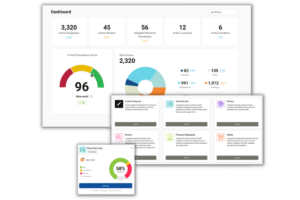
Healthcare compliance teams understand the importance of regulatory risk management…the real challenge is making it actionable. It can’t just show up in binders or annual assessment, it needs to operate in real time and support everyday decisions and practices.
Most organizations already track risks in some form, but identifying risk is not the same as managing it.
True risk management means giving someone ownership, following up on mitigation plans, and making sure risks stay visible and prioritized.
What Regulatory Risk Management Actually Covers
The most commonly associated definition of regulatory risk is the possibility that new or changing laws or regulations will affect an organization’s operations or expose it to penalties. The term gained traction in financial services, where changes in policy could have an immediate impact on profitability or strategic direction.
In healthcare, that definition is still applicable. However, regulatory risk also overlaps with a second category: compliance risk, which refers to failures to meet current legal requirements, industry standards and norms, or internal policies. Under compliance risks, organizations may face issues like outdated procedures, incomplete training, or substandard documentation, even when the governing regulation has not changed.
In practice, it is important that healthcare organizations manage these two risks together. Enforcement standards, interpretations, and operational expectations may change even if the regulation itself does not. Compliance and regulatory risks could potentially emerge from:
- Changes to HIPAA security or privacy standards
- CMS billing guidance that conflicts with internal practices
- Inconsistent patient rights enforcement across state lines
- Vendor agreements that don’t reflect the latest compliance rules
- New safety requirements under OSHA
While regulatory risk deals with legal updates, and compliance risk relates to obligations already in place, both can expose organizations to legal, financial, or reputational harm. Risk management efforts need to address both types of exposure to ensure the organization remains aligned not only within the law, but also with expectations around how that law is applied.
Where Healthcare Compliance Teams Often Face Challenges
Regulatory risk issues rarely come down to a lack of effort; most teams are doing their best with the systems they have. But when the tools are disconnected or the structure is unclear, even well-intentioned processes can start to break down.
Some of the most common challenges include:
- Fragmented tracking: Risk logs, policy documents, and mitigation plans may exist, but in different systems. Without integration, things fall through the cracks.
- Vague accountability: Risk may be identified and assigned during planning, but doesn’t always stay tied to an owner during execution. Without clear follow-through, simple documentation can turn into costly consequences.
- Outdated assessments: Many risk assessments are written in response to specific events. But if they aren’t reviewed regularly, they can start to lose relevance as workflows shift and new risks emerge.
- Limited integration with daily work: When risk management isn’t tied to staff training, vendor oversight, or policy enforcement, it becomes easy to ignore and hard to act on.
What a Functional Risk Management Process Looks Like
A good system keeps everything in one place, helps teams act on what they’re seeing, and doesn’t create more complexity than it solves. At minimum, it should include:
- A centralized system
All assessments, risks, mitigation steps, and follow-ups should live in one location. If you can’t easily see what’s being done, by whom, when, and how it’s not actually being tracked. - Consistent scoring and prioritization
Not every risk matters equally. You need a system that lets you sort based on impact and likelihood so you’re not spending time on something low-level while something more serious gets missed. - Tied to actual people and timelines
If no one’s responsible for it, it won’t get done. Every risk should be tied to a real person and a specific timeframe. - Connection to broader compliance efforts
Risk management should not be siloed. It should tie into what’s already happening: policy reviews, vendor monitoring, audits, or training. That way, it can be easy to act on and hard to ignore.
A well-rounded system like this doesn’t just check a box…it supports productive decision-making, keeps teams aligned, and turns risk management into something that’s functional. When it’s built into the work that’s already happening, it stops being a separate task and starts being a core part of how the organization runs.
A Word on Vendor Risk
Vendors are one of the most common blind spots in healthcare compliance. They often fall outside HR and audit systems, but they can still touch sensitive data, billing systems, and patient services. They may even be on an exclusion list. When vendor compliance slips, your organization can still be at risk.
Risk assessments are most effective when they include vendors directly. It is important that their documentation and certifications be tracked the same way internal records are, and someone on your team should be clearly responsible for keeping that oversight in place. Contracts should reflect current regulatory requirements, not just the ones in place when the terms were originally negotiated.
Pulling vendors into your broader system in these ways closes the gaps before they turn into liabilities.
Where Software Makes the Difference
Many healthcare compliance teams manage risk manually: in spreadsheets, local folders, or disconnected systems. That can make the process harder than it needs to be and increases the chance of something slipping through.
Compliancy Group’s advanced risk assessment tool helps streamline this. It offers:
- Structured assessments aligned with regulatory frameworks
- Flexible tools for scoring and categorizing risks
- Central storage for incident management, mitigation plans, and follow-up actions
- Direct links to training materials, policies, and vendor records
- Real-time reporting across departments
Final Thought
Regulatory compliance risk management isn’t about predicting every possible change. It’s about building a system that helps your organization stay stable when those changes happen. That system should be easy to maintain, clear to navigate, and flexible enough to keep up with your operations.









